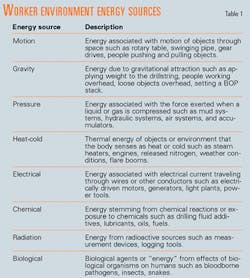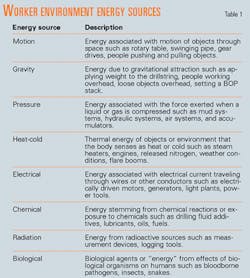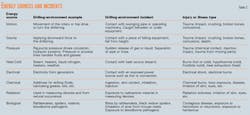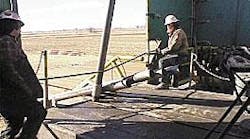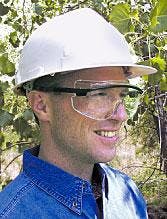Energy sources are the origin of hazards in the workplace. To prevent accidents, workers must recognize and identify hazards effectively, which requires them to understand these energy sources.
Because of the wide variety of hazardous energy sources in the oil and gas industry, and especially in the drilling environment, safety training programs must help workers to recognize the sources and understand ways to manage them safely.
A drilling contractor, implementing a training strategy based on teaching its crew members energy-source recognition, observed sharp declines in recordable and lost-time incidence rates.
Industry has many safety process tools and programs that are designed to help prevent accidents in the workplace. They all focus on managing energy by eliminating it, controlling it, or providing protective barriers.
Helping workers learn how to recognize the presence of energy is paramount to hazard identification.
Teaching hazard recognition through energy-source identification enables management to provide a strong foundation for accident prevention at the place it is most important-the workplace.
Accident prevention is a mental process that plans for expected events and anticipates unexpected events that could produce an incident. It depends on how well workers recognize and manage energy sources.
Hazard recognition
Ask anyone in the oil and gas industry, "What is the first step in accident prevention?" They often respond, "know ing the hazards." This may sound like a simple concept but the petroleum industry finds this to be a monumental task in day-to-day field safety.
In the industry's continuous efforts to reduce risk in the workplace it searches for a better way to communicate fundamental accident prevention information to its workers-namely "hazards."
The rig manager, well supervisor, or production foreman wants to communicate the safety message efficiently. The driller, rig operator, or gangpusher needs information or "tools" that are simple to use and easy for his people to understand.
The safety professional needs tools that apply broadly across the company and he values tools that have high overall effectiveness.
All of these team members reach for the same goal-a common understanding of hazards that employees can apply to routine jobs as well as unique tasks.
Using energy source identification as the foundation for hazard recognition can help each team member meet accident prevention objectives for themselves as well as for their organizations.
Better safety tools
Companies may never realize the ultimate hazard recognition process because they are working with the somewhat unpredictable nature of human behavior.
Industry has invented programs and processes ranging from systems safety and compliance programs to behavior-based safety-always searching for better tools to stop accidents.
Examining today's safety programs, most are geared to help workers or teams of people implement a technique to avoid an incident. The challenge is to find techniques that will help workers clearly understand the underlying causes of all accidents.
Hazard recognition cannot be efficient if a safety program applies the "hazard list" approach, attempting to identify every single arrangement of man, machine, and materials that could produce a downgrading event.
The petroleum industry's drilling, production, workover, and processing facilities represent thousands upon thousands of different arrangements of these variable components of the accident equation.
Trying to list all of these potential situations results in a mind-numbing "hazard list" that no one can effectively remember. It is not a productive approach.
In addition, the industry's current safety processes, including job-safety analyses and behavior-based safety systems, assume that workers are skilled in identifying the hazards as a prerequisite to job planning or task execution.
E.S. Geller points out that cultural change requires people to understand basic principles and how to use them.1
By focusing on the principles behind hazard recognition, people are not required to memorize a list and can become more effective at recognizing hazards in whatever situation confronts them.
The basic principles of hazard recognition are rooted in understanding energy sour ces and how they can cause accidents. Understanding that energy sources drive all accidents will allow people to recognize hazards easily and efficiently.
All accidents or downgrading events that occur in any operations require at least one form of energy to produce the final outcome.
Whether the final result was a broken bone, a smashed finger, a laceration, or a chemical exposure, some energy source (or combination of energy sources) drove the incident. All safety programs and processes aim to stop the unexpected energy release or contact with an energy source.
Learning about energy
As young children we begin to learn about how our interaction with the world can be painful. These nuggets of knowledge are the precursors to understanding how accidents occur.
When did you first learn that electricity could bite? Think for a moment about the first time that you encountered electricity-what were you doing and what happened to you? Many of us can remember a single, particularly instructive event.
A friend tells a story about his young son coming into the living room one evening crying, saying "Mickey Mouse bites," and pointing to his bedroom. Wanting to get to the root of the problem, the father follows his son into the bedroom.
His son pointed to a small "Mickey Mouse nightlight" that was plugged into a wall socket. In attempting to remove the nightlight from the wall socket, he had touched the nightlight prongs and was "bitten." In his mind the "hazard" was "Mickey Mouse."
Of course the nightlight was not the cause of the pain or the hazard-it was the electric current coursing through the prongs of the nightlight base that caused the pain.
Although this example may seem simple, the essence of the young boy's reaction is often seen when adults are involved in accidents.
For example, accident investigators often hear the following statements:
"I didn't know it would do that."
"If we had seen that part we wouldn't have done the job that way."
"If we knew what that sound meantellipse"
These statements reflect a lack of understanding of the energy source involved in the incident. Most accidents involve someone who did not recognize the presence and magnitude of an energy source.
Through instinct, humans recognize many hazards in the natural environment, such as poisonous snakes or heights. There are many energy sources and hazards in our modern environment that do not, however, elicit an instinctive reaction.
For example, exposed electrical wires do not cause an instinctive reaction in humans unless they have previously had unpleasant experiences with electricity.2 In order to survive, we must learn about these energy sources and how to avoid being injured by them.
Bolted flanges are common in the petroleum industry. What energy source does a bolted flange represent? Most people who have been in the oil and gas industry for a long time will respond that it represents pressure.
But they did not necessarily know this when they first started working in the industry-they learned from experience.
In trying to recall how they learned about specific hazards, some may remember that the knowledge came from trial and error, some may have taken a course on equipment, but most people will simply respond by saying, "I don't remember," or "It's just common sense."
The point is that not everyone knows the source and magnitude of energy in our workplaces and it certainly is not common sense. Drilling rigs, workover units, production operations, and pro cess facilities have an enormous amount of energy present.
Instead of relying on common sense for identifying hazards, the industry should teach its workers about the presence and magnitude of energy sources and thus improve their common knowledge.
It is important to understand how humans collect information about the world around them-how they use their senses.
A key element of the hazard recognition teaching process must ensure that workers understand the clues in the workplace that indicate the presence of energy-clues that are identified by using our senses.
Plug banks for electricity, the hissing sound of a leaking pressurized line, the vibration of equipment, and warning signs are just a few of the hundreds of clues that indicate energy is present. These energy source clues are collected by our "common senses" such as sight, hearing, touch, and even smell.
As we grow older we learn about all sorts of energy-sometimes through trial and error and sometimes through education. Unfortunately we do not all appreciate energy to the same degree.
Take a new roughneck for example. The roughneck may understand "energy of motion" yet does not comprehend the mass and magnitude of a moving piece of conductor pipe being swung into position at the side of the rig and may try to stop it with his bare hands.
Of course that is a recipe for an accident. But why did he not "see the hazard?" The most likely explanation is that it was due to a lack of knowledge and how to apply that knowledge to the task at hand.
Energy sources
In oil and gas operations, it is necessary to use various types of energy to make work easy, efficient, more effective, and safe. The controlled use of energy results in "work." In some cases the energy is not necessary to do the job but is encountered in the process of performing the job.
There are eight major energy sources in our environment. Each energy source can range from benign to lethal in their effect. All of them can be useful. All of them can kill.
Table 1 lists eight energy sources. By categorizing energy sources into these eight types, people are better able to remember the kinds of energy sources and, consequently, the kinds of hazards that may be present wherever they are working.
Whenever an uncontrolled release of or contact with one of these energy sources occurs, there is an opportunity for an accident that can result in a variety of injuries or workplace illnesses.
We often describe an accident as a "burn" or a "broken leg" but, in fact, these are injuries and injuries are a result of the accident. The type of accident more directly relates to the form of energy and the method of contact with the energy than it is to the type of injury.
Table 2 lists the forms of energy the workplace most likely will encounter, gives examples of these energy sources from the drilling environment, and shows the types of incidents and injuries or illnesses that can result from exposure to the energy sources.
The table shows how each energy source can transform into "an accident" that results in "injuries."
Why and how accidents occur
Accident prevention usually focuses attention on why accidents occur. A few of the major causes of why accidents occur include:
- Inadequate job planning.
- Unsafe procedures.
- Unsafe conditions.
- Faulty equipment.
- Inadequate design or configuration.
- Lack of attention.
- Lack of communication.
- Inadequate training.
Most companies examine the reasons why accidents occur in great detail, which is an extremely important part of the accident prevention effort. These companies often overlook the aspect of accident prevention, however, of understanding how accidents occur.
If each worker understands how accidents occur, personal responsibility and actions to prevent accidents become a powerful support for overall safety activities. All accidents result from the interaction of energy, equipment or materials, and one or more people.
Accidents and near hits occur by an uncontrolled energy release or contact with an energy source. The severity of injuries or illnesses ranges from minor injury to death.
The difference between a minor injury, a lost-time injury, or death depends on the energy source magnitude, the type of contact, and the contact duration. Thus, the first step in accident prevention is recognizing the energy source and the potential for an uncontrolled release of, or contact with, that energy source.
Effective prevention
From incident investigation and analysis processes, industry typically focuses health, safety, and environmental (HSE) activities on why events occur, which is useful in the broad context of managing information and improving incident reduction processes.
And yet these HSE activities may not focus on the immediate mental needs of the worker when he is outside in hot or cold weather faced with a task involving a number of different pieces of equipment, materials, and people.
Once the worker identifies an energy source and recognizes the potential hazard, the next step in accident prevention focuses on managing the energy. Trost and Nertney developed the theory of barrier analysis, which addresses the various ways that workers can manage energy sources.3
Managing the energy starts with improving the worker's knowledge of the sources and how to prevent the energy's uncontrolled release or contact. In all situations, the worker has three basic options available: eliminate the energy, control the energy, or provide a protective barrier.
- Eliminating energy sources. A common approach is to eliminate the energy source if the energy is not needed to perform the task. Isolating electrical equipment by opening a breaker switch and locking the breaker out is an example of "eliminating" or removing the energy source (Fig. 1).
The common term for this type of safety step is "lockout or tagout." Eliminating the energy also occurs with other energy sources such as pressure or chemicals.
- Energy source control. The crew must often work with the energy source to accomplish a task. Washing the rig floor with a steam line requires a high-pressure line and hose to control the energy (Fig. 2). Use of a low-pressure hose in this example would not provide adequate control over the pressure energy.
Other examples include bleeding pressure down sufficiently to operate certain types of valves. A common example for the control of energy is using a tagline while moving a piece of pipe (Fig. 3).
Workers must use energy of motion and gravity to move the pipe, but we must control that energy to ensure that it does not become an uncontrolled release.
- Protect against contact. Protective barriers, such as personal protective equipment (PPE) or equipment specific barriers, are the last line of defense against some energy sources.
Mechanical guards placed on moving machinery protect against "pinch points." Hard hats and safety glasses protect against falling and flying objects (Fig. 4). Respirators protect against chemicals or toxic gases. Safety toed shoes and boots protect against falling or striking objects.
Integrating energy sources
The concept of energy sources as the foundation of hazard recognition seems to make sense but how can the industry apply it? The industry can consciously integrate energy-source identification into basic oil and gas field safety pro cesses.
Several simple applications are readily apparent.
First, operators can include energy source identification in job-safety analysis (JSA) and similar job-planning processes. Each step in the JSA can include the task, the energy source, the potential hazard the source imposes, and the means of protecting against it.
The JSA can use simple letter codes for each form of energy to simplify documentation, such as G for gravity, E for electrical, etc.
The inclusion of an energy source identification step in JSA supports more comprehensive potential hazard identification.
Second, behavior-based safety processes can benefit by observing body position, body placement, and the use of safety equipment with respect to energy source presence and the potential for an uncontrolled release or contact.
Many behavior-based observation processes include an attempt to relate body position to the line-of-fire.
Line-of-fire is indirect reference to the potential release of some form of energy.
Third, overall job planning identifies energy sources and ensures they are effectively managed through energy source elimination, control, or provision for appropriate protective barriers.
Fourth, incident analysis can identify energy sources to determine what aspect of the job performance resulted in uncontrolled release of energy or contact with an energy source.
Case study
Although this hazard recognition approach appears to make more sense than other concepts, the drilling industry can only evaluate its effectiveness in the field.
Because the approach is relatively new, extensive statistics from long-term implementation are not available. A drilling contractor currently using the system to teach hazard recognition to its drilling crews, however, reports initial results that are encouraging.
Denver based CAZA Drilling Inc., in 1998, sponsored a safety-leadership training program that included hazard or energy source recognition as one of the key elements in the curriculum.
CAZA's management integrated hazard recognition with leadership because they recognized that both elements are essential to improve accident prevention performance.
Figure 5 shows the company's 1996-2001 relative incidence rate trends. The graph shows recordable-incidence rate (RIR) and lost-time incidence rate (LTIR) trends, in addition to man-hours worked.
Relatively high RIRs and LTIRs are clearly evident for 1996 and 1997. Both incidence rates decreased in 1998 following the introduction of the hazard recognition and safety leadership program, with the RIR rate showing the most dramatic decrease.
The LTIR rate decreased dramatically in 1999. Both incidence rates remained in the lower ranges for the next three years with slight increases in 2000.
In part, the company attributed the recordable and lost-time incidence rate increases in 2000 to CAZA's purchase of two other drilling companies along with the increased man-hours worked in 2000-01 by crews new to the company. This was according to CAZA's Rocky Mountain HSE manager, Dan Welschmeyer.
CAZA introduced the new drilling crews to the program, in 2000, lowering the incidence rates for 2001.
The incidence rates remained low compared to the significant surge in man-hours worked from 1999 to 2001 providing evidence that, everything being equal, RIR and LTIR are not directly related to man-hours worked.
Admittedly, the data are not extensive and cannot be used as a basis for rigorous statistical evaluation of different approaches to hazard recognition.
It is clear that the new training program, however, is having a significant effect on incidence rates and that a prominent feature of this safety leadership program is teaching rig crews how to recognize hazards based on understanding energy sources.
CAZA's crews use this energy-source approach in job-safety analyses and in their everyday approach to hazard rec ognition, highlighting the method's value. Available evidence strongly suggests that the approach to hazard rec ognition is effective to prevent accidents.
By fostering a cultural change with respect to hazard recognition CAZA Drilling has used considerable foresight in improving safety records.
There is a saying by Kwan-Tzu, the Chinese philosopher, that, "If you give a man a fish, he will have a single meal. If you teach him how to fish, he will eat all his life."
In the context of understanding energy sources as the basis for hazard recog nition, this concept becomes, "If you show a man a hazard, he is protected from that hazard. If you teach him how to recognize energy sources, he is protected all his life."
Energy source identification provides workers with an essential tool to help them recognize hazards and prevent accidents.
Acknowledgments
The authors thank CAZA Drilling's Ed Kautz, vice-president and chief operating officer, for permission to publish the company's safety incidence trends. We thank Randy Bennett, Aera Energy LLC, California, for his insights into hazard recognition and information on barrier analysis. We also thank Don Enslow, BP Exploration (Alaska) Inc., and Herb Williams, RigSafe Inc., Alaska, for information on hazard recognition in oil and gas operations. F
References
- Geller, E.S., The Psychology of Safety: How to Improve Behaviors and Attitudes on the Job, Chilton Book Co., June 1996.
- Wilson, E.O., The Future of Life, Alfred A. Knopf, 2002.
- Trost, W.A., and Nertney, R.J., Barrier Analysis, SSDC-29, EG&G Idaho Inc., Idaho Falls, Idaho.
The authors
Michael A. Fleming is president and founder of Decision Point Associates Inc. He is a certified safety professional with 24 years of experience in the oil and gas industry. He holds a BS in fire protection and safety engineering technology from Oklahoma State University, Stillwater, and an MBA from the University of Dallas.
R. Farley Fleming is vice-president of Decision Point Associates Inc. where he focuses on risk management and regulatory compliance. He holds a BS in zoology, with a minor in chemistry, from Texas Tech University, Lubbock, a PhD in geology from the University of Colorado, Boulder, and an LLM (master of laws) in natural resource and environmental law from the University of Denver College of Law.
